Inside Toyota's Higashi-Fuji tech center – Click above for high-res image gallery
Sitting in the shadow of Mount Fuji, Toyota's Higashi-Fuji technical center is part proving grounds and part engineering center. But unlike most facilities, Higashi-Fuji includes an array of engineering and research offices employing over 3,000 employees, and an assortment of non-track test facilities.
The Higashi-Fuji campus opened back in 1966 and has grown to encompass nearly 2.7 millionsquare feet of facility floor space. We were given the rare opportunity to visit the facility where we witnessed one unique crash test, tried out one of the world's most advanced driving simulators and sampled an assortment of new safety features, including a brake override system, enhanced pre-collision braking, pedestrian detection and updated ABS calibrations for the Prius. Make the jump for the full report.
Crash testing
One of the newest facilities at Higashi-Fuji is its crash test building, which includes a new angular multi-vehicle crash setup that allows engineers to crash two vehicles head-on at anywhere between 15- to 90-degrees and at speeds up to 87 mph.
Crashing vehicles at various angles is more complicated than a standard head-on impact as the timing must be carefully controlled. A few milliseconds or miscalculated angles at the point of impact can dramatically vary the results, making test repeatability and validity very difficult. During our visit, Toyota conducted a crash between two Camry sedans, each traveling at 40 mph and at a 15 degree angle.
Like other crash test facilities, the impact area is surrounded by high-speed cameras and lighting arrays, including the area below the cars. Toyota has installed a transparent floor comprised of a 280 millimeter acrylic panel with another thinner 6mm panel on top. As it gets scratched from use, the top layer can be replaced to preserve visibility. The thick layer can support a 22-ton dynamic load or a 10-ton static load.
One of the more compelling aspects we witnessed when watching the impact replay of a crash test is what happens to the headlight modules on the outboard side of each car. The headlamps on both cars we saw crashed were ejected and flew across the crash area. If such an impact were to occur on the street, these projectiles would put pedestrians at serious risk. We brought this up with the Toyota engineers who acknowledged that this scenario was unlikely, but warranted further investigation.
Crash simulation
Full vehicle crash testing is very expensive, and while Toyota conducts some 1,600 impacts per year at its global facilities in Japan, Europe and Ann Arbor, MI, it also does vast amounts of simulation work. Like other manufacturers, Toyota executes hundreds of thousands of iterations of its vehicle simulations. Those simulations are able to predict what happens to the vehicle structure, but until recently, they were unable to measure anything about its occupants.
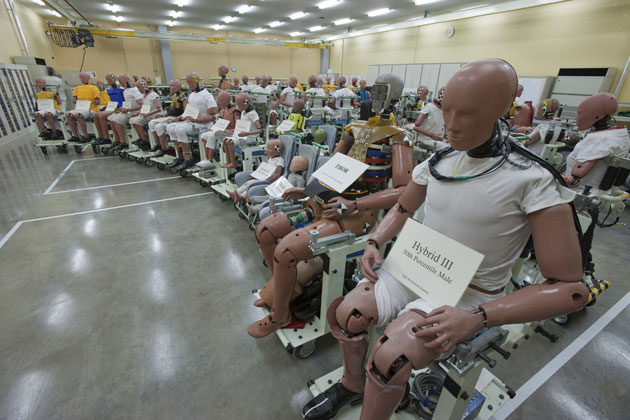
To that end, Toyota's computer engineers have created the Total Human Model for Safety (THUMS) to simulate what happens to a body during a crash. The THUMS project was kicked off in 1997, with the first version released in 2000. The original 50th percentile adult male (AM50) model featured major bones and ligaments and had 80,000 elements. Each successive version has added more detail, with version three adding in a model of the brain. Version 4.0 was just released and adds internal organs, bumping the element count to 2,000,000 components.
Toyota has made its THUMS model available to other researchers and manufacturers for several years. The Ver. 3 AM50 model, for example, is available for $80,000. The Ver. 4 model isn't available outside of Toyota yet, but it adds models of a small woman, a pregnant woman and six- and nine-year-old children.
Advanced driving simulator
Following our look at Toyota's crash testing capabilities, we had the opportunity to go for a spin in Toyota's new advanced driving simulator. At first glance, this unit looks similar to those operated by Daimler and Ford – a platform surrounded by a 7.1-meter dome sits on a hydraulic tilt system. Inside the dome (see first image above), a Lexus LS body is mounted on a turntable and a 360-degree projection system produces a high-resolution driving environment. Toyota has also installed a shaker mechanism at the corners of the car to replicate different road surfaces.
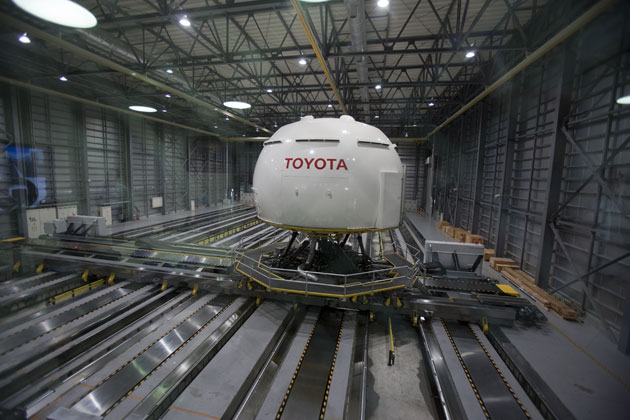
More interestingly, Toyota has one-upped its competitors on the outside of the dome. The Daimler and Ford simulators can tilt and rotate, but the overall mechanism stays in one place. The Toyota system can move the entire apparatus through a 35-meter longitudinal range and 20 meters side-to-side. This makes the sensations felt by the driver much more realistic. The system can move at up to 13.6 mph and accelerate at up to 0.5 g. We know what we want for Christmas this year, but we'd prefer an LFA in place of the LS.
We went for a simulated run in the town surrounding the technical center and found the experience to be incredibly realistic. The combination of the tilt, rotation and translation capabilities allow the driver and vehicle occupants to experience the sensation of driving. Some responses were a bit more exaggerated than expected and felt a bit under-damped – not unlike a 1972 Buick. However, this is something that could be adjusted with improved calibration of the mechanism. The car has several cameras installed that allow the operators in the control room to monitor the driver's behavior in a variety of scenarios. Actual testing with the simulator began in 2008, and Toyota has been bringing in regular drivers ever since to evaluate scads of situations, including driver distraction, drowsiness and response to collision warning systems.
Pedestrian detection and pre-collision braking
From the simulator, we climbed into a fully functional LS equipped with Toyota's new pedestrian detection system and a more advanced version of its existing pre-collision system (PCS). Lexus has offered its PCS system on a number of models for some time, utilizing the millimeter-wave radar system originally developed for adaptive cruise control to detect an impending collision. If an imminent impact is detected, the seatbelts are pre-tensioned and the brake calipers pre-filled with fluid so as soon as the brakes are applied, full power is available. If the driver neglects to respond to a warning and hit the brakes, the system will apply the brakes with up to 0.3 g of deceleration, reducing the impact force or eliminating it entirely.
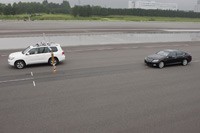
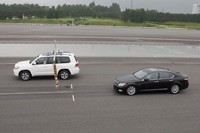
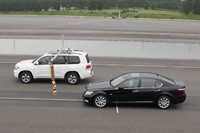
The next generation of this system adds a pair of forward-facing cameras to enhance resolution and then automatically apply the brakes earlier and more aggressively. We compared the current system back-to-back with the more advanced version, accelerating to 40 mph and approaching an object moving at five mph without braking. The original system detected the object and slowed our vehicle but still hit the object at about 15-20 mph. With the newer version, the car came to stop just shy of the obstacle without ever necessitating our use of the brakes.
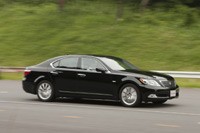
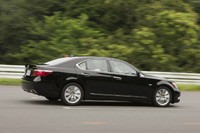
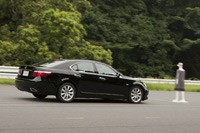
The next step beyond pre-collision systems is pedestrian detection, a similar system to what Volvo introduced on its new S60. In the case of the Lexus, Toyota has added an infrared projector to the cameras and radar that incorporates the advanced PCS system. The cameras allow the vehicle to recognize and distinguish between a pedestrian and other objects, and they employ sensors that gauge both visible light and infrared to aid visibility at night and in poor visibility. For our test, we accelerated to 25 mph and held that speed as we approached a mannequin in the vehicle's path. The system detected the object and brought the LS to a full stop just short of the plastic pedestrian – and we never touched the brakes. At higher speeds, the vehicle would still hit the pedestrian, but the collision force would be greatly reduced, reducing the severity of the injuries. Both the advanced PCS and pedestrian detection are at least two-to-three years away from introduction on Toyota and Lexus vehicles.
Brake override system
The two most recent developments we experienced during our Toyota safety walk-through are directly related to the recent recalls of the company's vehicles. Earlier this year, Toyota committed to adding a brake override system (BOS) to all of its vehicles by the end of 2010 as a response to the claims of unintended acceleration. The intent of brake override is to ensure that a vehicle can stop safely and promptly even if the engine is racing. Before testing the BOS, Toyota's engineers wanted to demonstrate that even without it, their vehicles' brakes could overcome engine torque and come to a halt.
BOS should give Toyota drivers a bit more confidence that they can stop if the accelerator is matted to the floor.
In a Lexus ES350, we accelerated to five mph and then floored the accelerator to ensure a wide open throttle. At 40 mph, we applied the brake pedal about halfway through its travel with our left foot, and the vehicle easily slowed down and came to a stop – with the accelerator pinned to the floor the entire time. The stopping distance was noticeably extended compared to a similar test with the accelerator released, but the car did come to a halt.
Toyota's engineers then enabled BOS and we tried the same maneuver. The system is activated when the vehicle is moving more than five mph, the throttle is 1/3 or more open and the driver applies medium brake pressure or more. After we reached 40 mph with the gas pedal still on the floor, we applied the brake with our left foot, and the engine speed almost immediately dropped to idle. With the engine load removed, the same brake application we used on the first run brought the ES to a halt much more quickly. The five mph criteria for BOS activation means that if Camry drivers really and truly feel the need to do some brake torque launches, they will still have that capability and the mild brake application will allow for some left-foot trailbraking into corners (huzzah!). Either way, BOS should give Toyota drivers a bit more confidence that they can stop if the accelerator is matted to the floor.
Prius ABS recalibration
Our final evaluation was the re-calibrated ABS for the company's third-generation Prius. Following last year's introduction of the latest model, some drivers began complaining of a loss of deceleration when the anti-lock brakes activated with a light brake application. This is always a tough area for ABS engineers to handle, and the automaker's standard brake tests are all performed with what's known as a "spike" apply to the brake pedal. In this scenario, the test driver steps hard and fast on the pedal to simulate a panic brake activation.
The video meant to be presented here is no longer available. Sorry for the inconvenience.
When excessive wheel-slip is detected, solenoid valves in the brake system alternately reduce and increase the brake pressure to the wheels trying to hold slip at the optimum level for deceleration and stability without allowing the wheel to lock. With a hard brake apply, the pressure head at the apply valve is high (1,000-2,000 psi) and it's relatively easy to control the wheel pressure consistently. Opening the apply valve for a few milliseconds at a time gives a predictable pressure increase across the orifice in the valve.
The video meant to be presented here is no longer available. Sorry for the inconvenience.
The problem comes when the driver does a light brake application, during which the upstream pressure may be only 200-300 psi or sometimes less. In this case, the pressure response across the apply valve is far less predictable. Generally speaking, when the wheel speed sensor readings are indicative of this scenario, the engineers are more conservative with the system calibration. Applying too much pressure can easily cause the wheels to lock, leading to instability or rough control. This is exactly the scenario the Toyota Prius engineers faced, and they may have gone a bit too light on the ABS pressure re-apply pulses.
The result is that applying the brake just beyond the threshold of adhesion on a slippery surface would cause ABS to activate with a pressure reduction, followed by noticeably lower deceleration than what was present before activation. The measured deceleration is not that different, with perhaps 0.15 g before and 0.01 g after ABS. We tested the Prius on a wet ceramic tile surface with the original calibration and experienced this exact condition. Then we got into another Prius with the updated calibrations and noticed that the difference was less dramatic and overall deceleration was more consistent.
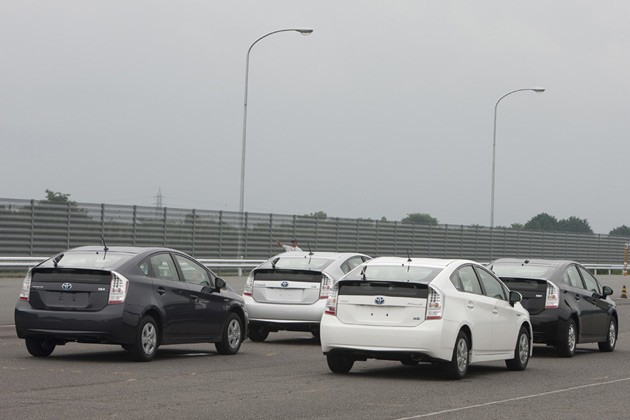
The reality is that most drivers will never experience this scenario as they will typically brake hard enough that the loss of deceleration is not apparent. However, for those who do, the update should provide increased confidence in the Prius' stopping power. There is, however, a risk involved with this change. It's possible that under some conditions, Prius drivers will experience rougher control during ABS and possibly even momentary wheel lock. These calibrations are always a compromise, and the next time we get a Prius to test we'll see if we can try it under different braking conditions to evaluate the trade-offs.
One thing became abundantly clear from our day at Higashi-Fuji: Toyota is definitely listening to complaints that have arisen from the way that its vehicles are used in the real world, and they're working to make adjustments in the hopes of pleasing the customer. Will this be enough to help it recover from its current quality and recall crisis? Sales numbers over the next few years will be the best indicator, but we can say with confidence that Toyota is trying.
Autoblog was invited to the Higashi-Fuji technical center by Toyota, which provided our travel and accommodations.
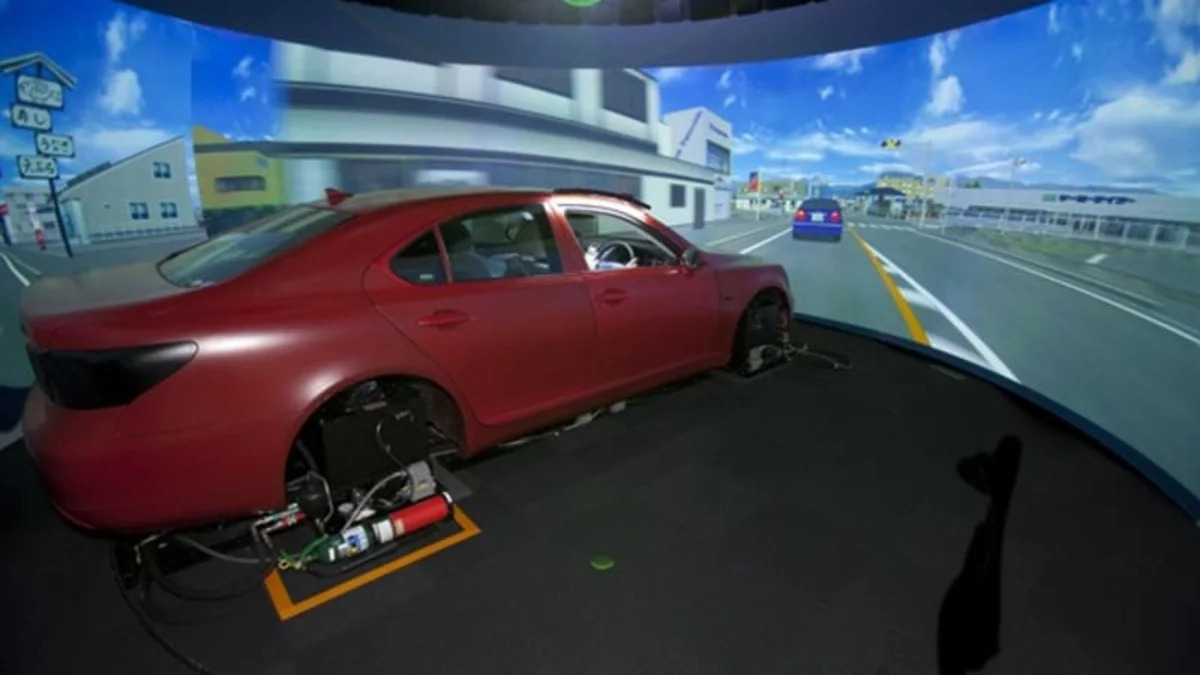
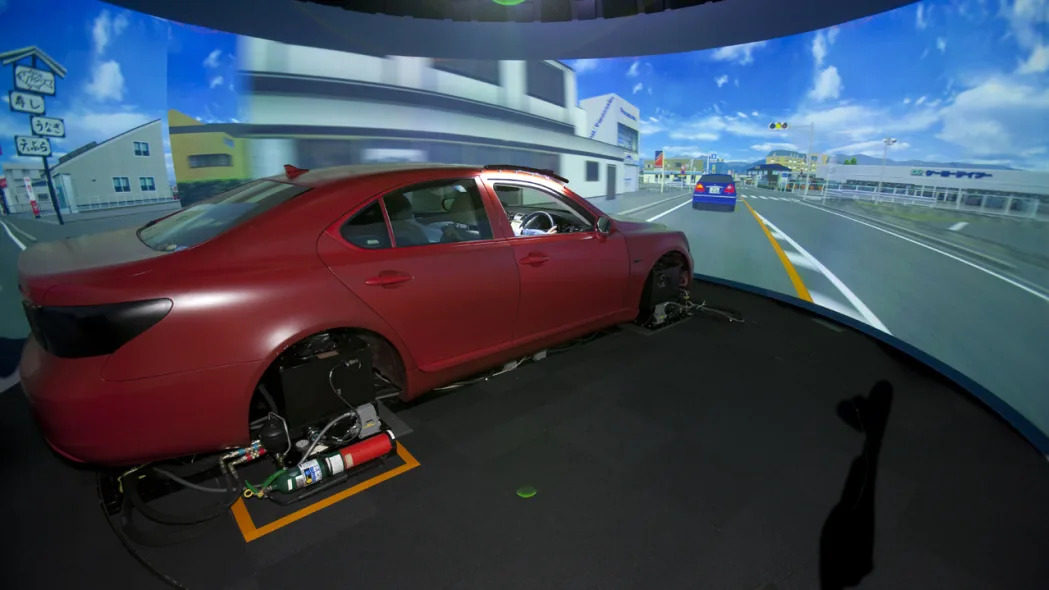

Sign in to post
Please sign in to leave a comment.
Continue